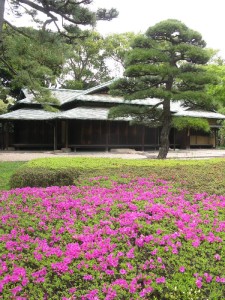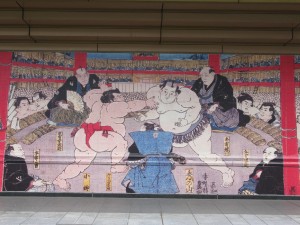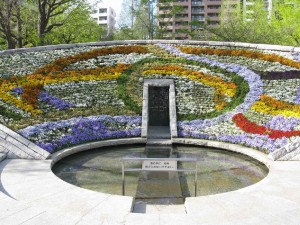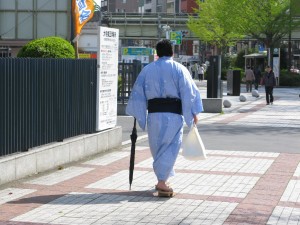If Tokyo has a centre then it’s occupied by the Imperial Palace, an 850 acre oasis that forces all the roads to divert around it. Occupying the site of a 15th century castle, about a third of the area is the home of the current imperial family and only accessible by guided tours, the rest is now split into three public parks. With the sun shining once more, we longed for some greenery again. The East Garden is the largest of the parks, and we approached via the anonymous skyscrapers of the Marunouchi business district. The area seemed completely sterile until I realised that there actually were shops and restaurants lurking behind the bland facades or hidden down in basements.
The gardens lacked the careful design of Shinjuku Gyoen and some of the planting seemed a bit random, but they were pretty. There was still some cherry blossom, especially the fat pink double kind (less admired than the single white varieties in Japan), red maples just coming into leaf, and a bank of white rhododendrons. In one area low, neatly clipped hedges of tiny leaved azaleas were just coming into brilliant pink and red bloom: they will be spectacular when they’re fully open. The park also holds some of the ruins from the Edo period, which have been heavily restored. Too heavily really – they just look too neat. Actually the stonework reminded me of Inca ruins, with its massive, mortarless irregular blocks.
When it clouded over we took the subway to Ryogoku, intending to go to the Edo-Tokyo Museum, but we decided first to peek in at the Sumo Museum which is part of the stadium where the tournaments are held. I don’t have any great interest in sumo but it is an iconic Japanese sport, and very popular there – few seats for the next tournament were still available. The museum was very small, just photos of famous wrestlers (famous to sumo aficionados, that is) and a few of the heavy embroidered aprons that they wear, but we did see a wrestler walking in the street – a huge man dressed in a pale blue robe and wooden shoes far too small for him.
By now it was late afternoon and we realised that we didn’t have the time or energy to do justice to the Edo-Tokyo Museum, so instead we walked further along the road to the Earthquake Museum. It was mostly burned articles and photos of the catastrophic Great Kanto earthquake in 1923, which resulted in devastating fires that killed tens of thousands. Upstairs were some photos of the damage inflicted on Tokyo by WWII bombardments. With all that destruction it’s not surprising that authentic historic buildings seem to be in short supply in Tokyo – most old landmarks, such as the Sensoji Temple, have been completely rebuilt. If the predictions are correct, that Tokyo is likely so suffer a major earthquake within the next few years, they may have to be rebuilt again in the near future. Tokyo is a great place – but I’d be wary of staying around for too long.






